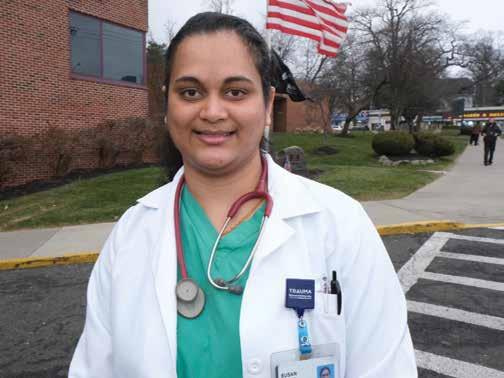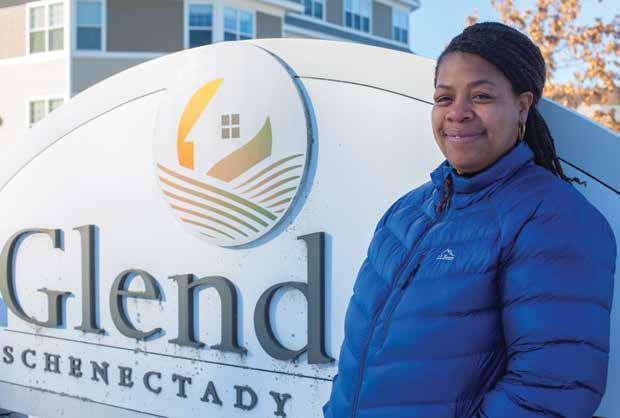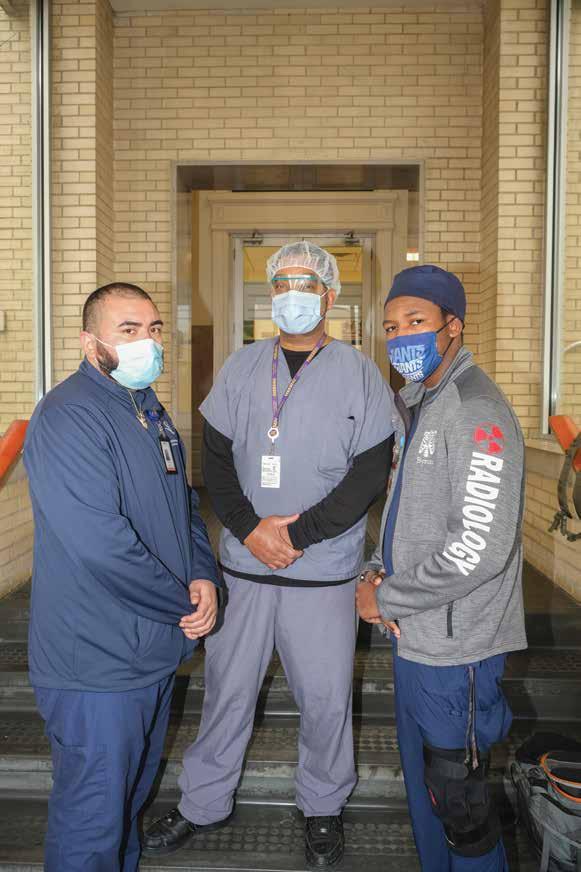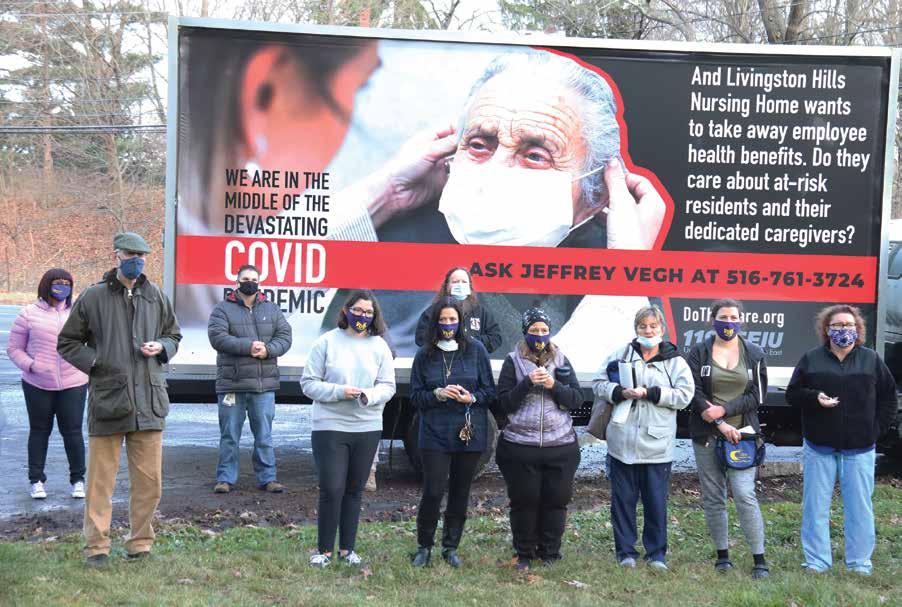
8 minute read
Fifty Years of
from 1199 Magazine
by 1199SEIU
Retiree Fritz Joseph, displays some of his artwork at his Brooklyn home.
Fifty Years of Discovery, Creation and Caring
Advertisement
In retirement, Kingsbrook Jewish Lab worker Fritz Joseph is devoted full time to art.
In January, after 50 years at
Kingsbrook Jewish Medical Center in Brooklyn, Clinical Laboratory Scientist Fritz Joseph hung up his lab coat for the last time. At retirement age and with Kingsbrook’s lab downsizing, Joseph decided to dedicate his life full-time to art. (See pages 12 and 13 for story about Kingsbrook’s transformation.)
A renowned painter and sculptor whose images of Haitian and Caribbean life have been shown at prestigious institutions, including the Brooklyn Museum, Joseph previously juggled his love for the arts and the sciences.
“When the lab closed, I was like the captain saying goodbye to his ship,” he says. “I was the last one to close the lab because our services began shifting to Brookdale Medical Center. It was bittersweet, but I have learned so much from my directors and the people I worked with.”
Joseph arrived in New York City in
1967 with a dream of becoming an architect and a degree from Haiti’s Academy of Fine Arts. Joseph followed four of his brothers from Haiti to Brooklyn, where like many immigrants, they took jobs in health care. Since dreams don’t necessarily put food on the table, Fritz took a CNA job at Kingsbrook Jewish, where his late brother Jean Marie was working in the lab.
“I got the [Kingsbrook lab job] when Jean Marie left to study medicine in Europe. I was more interested in studying architecture at Brooklyn Technical College, but Jean Marie encouraged me to take [science] courses while training me for the job,” says Joseph.
Over time, Kingsbrook Jewish became the intersection of Joseph’s life as an artist, lab scientist, and caregiver. Joseph volunteered outside the lab during his lunchtimes, lecturing about art and teaching patients in recreational therapy. As painter and sculptor, Joseph is a creator of and witness to the evolution of image and form. His lab specialty of histology is not dissimilar, he says; both demand patience, empathy, and mastery of numerous skills acting in concert.
“I was able to witness the evolution of histochemistry from A to Z. I learned to work with the electron microscope, to examine frozen sections, and to make reagents from conventional to microwave techniques and immunoprocedures, as well as doing special staining for different tissues such as mucosubstances, connective tissues, for fungi, for acidfast bacteria, mucicarmine, congo red, and other abnormal proteins surrounding tissues for amyloidosis.”
Over time, says Joseph, he came to
see his work in histology as a fine art.
I’d refer to some procedures in the field as Rembrandt [after the artist], or even Winsor & Newton [a British supplier of fine arts materials],” he adds.
Joseph is now devoting himself full-time to organizing exhibits, writing criticism and poetry, and supporting emerging artists from the Haitian and other Black, Indigenous, and communities of color. He is excited but will miss the pathology lab.
Says Joseph: “Human tissue, nuclei, cytoplasm, myelin sheaths, neurofibrils, etc., may offer under microscopic examination a view of another universe that one can hardly imagine with the naked eye.”
Caregivers Are Also Healing Our Nation
1199ers will help build back better.
During an unprecedented national
crisis, 1199ers moved to the vanguard to defeat perhaps the worst president in our nation’s history. Now we are moving to the front lines to help our nation heal and move forward from a confluence of health, economic, social and democratic crises.
The road ahead is steep and long, they say. Too many members have witnessed the funerals of patients, colleagues, friends and relatives. Although healthcare workers as a whole have retained their jobs during the crises, loved ones and neighbors have lost jobs, savings and even homes.
Even before the pandemic, our nation’s healthcare system was sorely in need of reform. The Affordable Care Act––not comprehensive when it was passed––was further weakened by the last administration and its Congressional cronies. Prior to the pandemic, 87 million people in the nation were uninsured or underinsured. Since then, another 12 million have lost employer-based insurance. Medical debt remains the nation’s leading cause of bankruptcy. Healthcare workers face another crisis. “When the pandemic began, it became clear to me that working in a nursing home is the most dangerous job in America,” says Crystal Perry, an LPN at Glendale NH in Schenectady, NY. Recent reputable studies have found that while five percent of the nation’s COVID-19 cases occurred in long-term care facilities, deaths among residents and workers in those facilities accounted for more than 36 percent of the nation’s total. In twelve states, including Massachusetts, long-term care facilities accounted for more than half the COVID deaths.
Hospitals have also been battered. “I have never seen anything like
– Susan Philip, Orthopedic Physician Assistant at Staten Island’s Richmond University Medical Center and Staten Island University Hospital.
Susan Philip, RUMC Physician Assistant. this,” says Susan Philip, a per-diem orthopedic physician assistant at Staten Island’s Richmond University Medical Center and Staten Island University Hospital. Philip stresses that because COVID-19 tossed everyone into uncharted waters, coordination and cooperation has always been paramount.
That was sorely missing from an
administration characterized by denial, cronyism and incompetence. Instead of support from the nation’s capital, healthcare workers were accused of inflating the number of COVID patients and deaths in an attempt to increase funding. The lack of support from the former administration had a disproportionate effect on poorer communities, particularly those of color.
The pandemic has laid bare the failure of a profit-driven healthcare system and the systemic racism within it. “My work is at Broookdale in an underserved community, so I can’t compare my experience there to more affluent neighborhoods,” says Scheena Tannis, an RN for the past 15 years there. “I do know that the patients have been negatively impacted by lack of access and the overwhelming demand.”
Tannis stresses that the traditionally underserved should be prioritized. She is critical of the previous administration that failed to distinguish opinion from fact and that disparaged science. “You don’t call a plumber to fix your electricity,” she says.

“We are the essential workers, the hands-on workers who don’t have the luxury of sitting behind our home computers,” Perry says. She has the additional responsibility of trying to shield her grown children from infection. “I live with four children and my fiancé, so we have to be extra careful,” she says.
Perry’s son, a restaurant chef, and one of her daughters, a grocery-store worker, were recently laid off. “None of my children have the benefits that I do because they aren’t union members,” she says sadly.
She noted that the first weeks of the vaccine rollout were plagued with disorder, delays and disinformation. New York was not an exception. Each state was left to fend for itself with little or no assistance from federal officials. The Biden-Harris team was not even granted the courtesy of a briefing on the work of the previous administration.
January 20 restored hope. The
Biden-Harris administration has forthrightly acknowledged the systemic racism built into our institutions. It has noted that during the vaccine rollout, the map of communities in which residents were fortunate enough to get vaccinations did not correspond to a map of the hardest-hit communities. The administration has promised to address that with the help of allies like 1199.
“Having a Union like 1199 helps with outreach and education and to get everyone on the same page,” says Physician Assistant Philip. “Instead of dropping the ball, we can work as a team.” RN Tannis also believes that 1199 can use its influence and prestige to get local and national leaders to work together. That has always been the Union’s posture. A major objective in 1199’s constitution is “to help achieve high quality health care and human services for all
The pandemic has laid bare our profitdriven healthcare system and the systemic racism within it.
Catherine Smith Photo people regardless of their economic status.”
The 1199 members interviewed all spoke of the pandemic’s emotional trauma and the healing that needs to take place. “Caring for each other is essential,” says Philip. “As healthcare workers, we must be concerned about all aspects of our patients’ wellbeing.”
“Concern, compassion and empathy is why I’m a nurse,” says Perry. “I put myself and my family on the line every day. And I know I have the support of my Union. 1199 can help lead us out of this disaster. But we must also use our power to hold our elected officials accountable.”
At press time, Philip, Tannis and Perry had each been vaccinated to protect themselves and their families and to encourage others to do the same. They want to set an example. Said Tannis of her vaccination, “I took one for the team.”

Crystal Perry, an LPN at Glendale NH in Schenectady, NY, says that the pandemic has highlighted the vulnerability of working families.





Dignity for Our Departed
(L to R) Jesse Aguirre, Gary Hilliard, and Bryon Howard work in the morgue at St. John’s Episcopal Hospital in Far Rockaway, Queens. They help ensure that St. John’s COVID-19 victims receive a loving and dignified transition. See story on pgs. 16-17.








